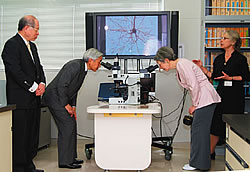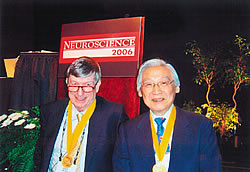An Imperial Visit
On October 3, the Emperor and Empress of Japan took a three-hour visit of RIKEN. Accompanied by RIKEN President Ryoji Noyori, the royal couple toured Nishina Center for Accelerator-Based Science and RIKEN Brain Science Institute. In the East Building of BSI, BSI Director Shun-ichi Amari and BSI Special Advisor Masao Ito used posters to introduce the couple to BSI. After which, the Vice-Director of BSI, Keiji Tanaka demonstrated how fMRI is used in brain science, and Takaomi Saido introduced possible approaches to treating and preventing Alzheimer's disease. Moving the the third floor, the royal couple learned about current efforts to understand cortical anatomy from Kathleen S. Rockland, who also showed them neurons through a microscope. Atsushi Miyawaki gave a demonstration of real-time color changes of fluorescent proteins using UV-rays and Hitoshi Okamoto then explained research on the development and growth of zebra fish neurons using fluorescent proteins. Noyori apologized that ongoing research into mental disorders, such as bipolar disease, could not be presented that day.
The Emperor and Empress listened attentively, asking questions until they understood the work in the time provided. The researchers were very impressed by the insight and detail of the questions made by the royal couple.
In Pursuit of A Scientific Explanation of the Unconscious Brain
Together with Prof. Robert Nicoll of the University of California in San Francisco, RIKEN Brain Science Institute's founder and first director, Prof. Masao Ito was awarded the Peter Gruber Neuroscience Prize for their efforts to uncover the secrets of memory. The two scientists, both students of John Eccles, were honoured for their studies of molecular and cellular mechanisms in the formation of memory-studies that helped establish the field of neuroscience.
In his acceptance lecture, at the five-day neuroscience meeting in the United States, Prof. Ito highlighted his work on long-term depression (LTD) in the cerebellum and the role this phenomenon play in motor learning by modulating synaptic strength. He pointed out that a similar process enables skillful and automated thinking, and in closing, Dr. Ito said that his dream was to explain Freudian notions of the unconscious mind with LTD.
The Neuroscience Prize is one of five international awards conferred by the Peter Gruber Foundation each year for pioneering work in science, human rights and justice. Seymour Benzer was awarded the Neuroscience Prize in 2004 and Eric Knudsen and Masakazu Konishi shared the prize in 2005.
Changes to BSI's Organizational Structure
On October 1, 2006, BSI combined the Cognitive Development Research Group and the Human Learning Research Group into a new group called the Intellectual Brain Function Research Group, directed by Atsushi Iriki. The three labs that comprise this new group are: Symbolic Cognitive Development, Biolinguistics and Language Development.
In addition, the two support divisions of Research Resources Center renamed. They are now the Support Unit for Animal Experiments and the Support Unit for Bio-Material Analysis and both are lead by Chitoshi Itakura. A third unit, called the Support Unit for Functional Magnetic Resonance Imaging and lead by Kang Cheng was created. Through these changes, BSI's research support system should become more efficient.
Organization of BSI (As of Oct. 1, 2006)







